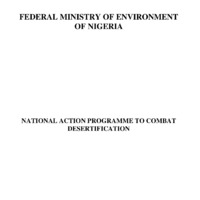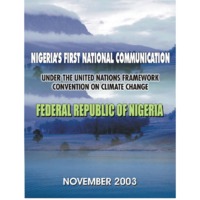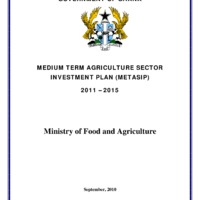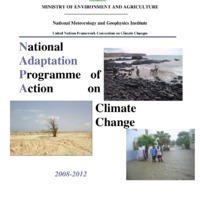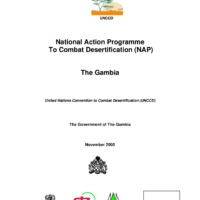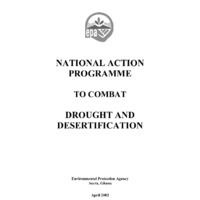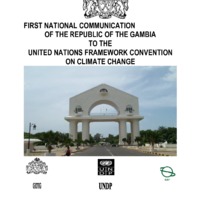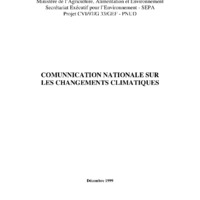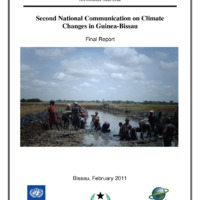Recherche
9 items
CNUCC NAPCD nigeria
The severity of desertification in the drylands of the world prompted the United Nations Organization to adopt a Convention to Combat Desertification (CCD), in 1994 for which National Action Programme (NAP) which Nigeria ratified in 1997. As a principal tool for the implementation of the Convention, parties are expected to prepare and implement NAP. Nigeria is a large country with a substantial part of its area extending into the Sudano-sahelian belt, which, together with the neigbouring northern Guinea savanna, constitutes the drylands of the country. With an estimated population of 113 million, human pressure on the land particularly in the marginal areas has continued to take its toll on the environment, resulting in desertification. Desertification is made very severe in the drylands of the country by increasing human attempts to exploit the resources of the ecological zone in the face of persistent drought. Before now, Nigeria has been tackling the problem of desertification the best way it could, but with little success. It is now obvious that the menace should be addressed in a holistic manner in order to ensure that the drylands of the country continue to support human and natural resources. This National Action Programme (NAP) spells out critical activities to be taken in a holistic manner to tackle the menace of desertification of the country. To facilitate a clear understanding of the NAP, an outline of the country’s environment is given, followed by a description of the extent and severity of desertification in the area. Also highlighted are the earlier efforts made to combat the menace, and the lesson learnt from such efforts. The NAP itself presents, guiding principles, issues, strategies and priority projects.
CNUCC Nigeria's initial national communication
Nigeria with a total area of 923,800 sq km occupies about 14& of land area in West Africa. The country lies between 4oN and 14oN, and between 3oE and 15oE. It is bordered respectively in the north, east, and west by Niger, the Cameroon, and Benin Republic, while the Gulf of Guinea, an arm of the Atlantic Ocean, forms the southern border. Most of Nigeria is covered with Pre- Cambrian rocks, but there are also metamorphic and sedimentary rocks of Eocene times as well as volcanic rocks. In general, three types of geologic structures exist in Nigeria, namely, areas of uplift, basins of sedimentation, and isolated volcanic areas. The areas of uplift are made up of the oldest rocks in Nigeria - the basement complex rocks.The basins of sedimentation are the down-warped areas, which were drowned by the sea at different times and in which sediments eroded from the areas of uplift were laid down.
Ghana medium term agriculture sector investment plan (metasip)
The Medium Term Agriculture Sector Investment Plan (METASIP) (2011 – 2015) has been developed using a largely participatory process and based on FASDEP II objectives with a target for agriculture sector GDP growth of at least 6& annually and government expenditure allocation of at least 10& of the national budget within the plan period. These targets are in conformity with agricultural performance targets of the country’s National Development Planning Commission (NDPC), the ECOWAP of ECOWAS and the CAADP of NEPAD and are expected to contribute significantly to the achievement of the MDGs of the United Nations Organization. As a sector investment plan, emphasis throughout the Plan has been on concerted consultations and actions by all stakeholders of the sector. The key stakeholders include MOFA, other relevant MDAs, DPs, NGOs, academia, civil society, farmers and other on-farm and off-farm private sector operators, researchers and service providers. Agriculture continues to be the largest sector of Ghana’s economy, contributing about 39& of GDP compared to about 26& for the industry sector and 31& for the services sector. Arable and industrial crop production has increased only marginally over the last 10 years with the only exception being cocoa which increased significantly between 2000 and 2005. Cotton and coffee production declined very significantly in the last decade. While there is little reliable information on the livestock sub-sector, it is known that the country’s meat situation is deficit to the tune of over 95,000 metric tonnes annually. There is similarly a deficit of about 460,000 metric tonnes with respect to fish. The identified basic problems of the agriculture sector include: reliance on rainfed agriculture and low level and relatively inefficient irrigated agriculture; low level of mechanization in production and processing; high post harvest losses as a result of poor post harvest management; low level and ineffective agricultural finance; poor extension services as a result of several institutional and structural inefficiencies; lack of ready markets and processing; low performing breeds of livestock; poor feeding of livestock; high cost of feed for poultry; poor livestock housing and husbandry management; competition from imports and poor post-production management of livestock products; over-fishing of natural waters; undeveloped fish value chain (e.g. inadequate supply systems for fingerlings and feed) and lack of skills in aquaculture. Strategies in the Plan to improve agricultural performance therefore focus on investments to address these constraints and to improve agricultural productivity and enhance market access. The six Programmes of the Plan which correspond to the six FASDEP II objectives have each been presented along development themes termed Components. POCC analysis was applied to the development issues of the themes to derive outputs and activities. It is envisaged that the Plan will be implemented by existing structures in the MDAs and other stakeholder organizations and that the Policy Coordinating and Monitoring Unit of the Office of the President and the NDPC will play key oversight roles during implementation. MOFA will xii facilitate the coordination of partnerships at all levels and play a lead role in the monitoring and evaluation of the Plan
National adaptation programme of action on climate change
Scientific conclusions indicate that the "warming of the climatic system is a reality”, while it is "very likely" that anthropic activities play an important role in temperature rise. Effectively, global temperatures have risen by about one degree since the end of the nineteenth century, while the levels of CO2 concentration in the atmosphere have increased and accumulated by approximately 30& during the same period.
PANLCD Gambie
The Second National Forum adopted the “National Action Programme to Combat Desertification in The Gambia” in Banjul on the 27th of September 2000. Preparation of the National Action Programme (NAP) was coordinated by the Forestry Department, the Focal Point for implementing the United Nations Convention to Combat Desertification in The Gambia (UNCCD). Formulation of the NAP was the result of a broad, consultative process, involving central government and its line agencies, local government institutions, Non Governmental Organisations and, most importantly, communities all over the country whose perceptions, views and proposal were gathered in zonal and divisional meetings, numerous interviews and statements. At the First National Forum held in November 1998, five thematic areas were identified for in-depth consideration in the NAP. These included: Forestry and Wildlife Management; Agriculture, Soil and Water Conservation; Livestock Production and Range Management; Population and Social Dimensions of Desertification; and Institutional Arrangements. Five separate sectoral studies were prepared by international and national consultants, identifying the key issues for each sector, progress made in the fight against desertification, and areas requiring immediate and medium-term action. Based on this analysis, the Second National Forum was held, and the final National Action Programme adopted. Technical and financial support was extended by the Deutsche Gesellschaft für Technische Zusammenarbeit (GTZ) GmbH, through the Deutsche Forstservice (DFS) GmbH, the United Nations Sahelian Office (UNSO), the United Nations Development Programme (UNDP), the Secretariat of the UNCCD, and the Permanent Inter-State Committee to Combat Drought in The Sahel (CILSS). The Gambia is, a small and poor country, but, nevertheless, has made substantial progress in key areas of relevance to The Convention. Headway has been made in The Gambia in reversing the trend of deforestation, and the future looks promising in these areas indeed. In fact, elements of the Gambia Forestry Management Concept are being taken-up in the Sub-Region and beyond. The National Action Programme is structured with a brief introduction and presentation of background information on The Gambia in Sections 1 and 2. These sections set the stage for the discussion of the impact of desertification in The Gambia in Section 3. Section 4 covers the NAP preparation process and provides a synopsis of analysis provided by the five sectoral studies commissioned during the NAP preparation. Finally, the National Action Programme is detailed in Section 5, including guiding principles, priority measures, institutional and financial arrangements, and monitoring and evaluation of the NAP. A brief summary of the Second National Forum with key conclusions and recommendations follows. In Appendix A, a matrix summarises the key stra 3 tegic areas requiring priority action. A full investment programme will follow in early 2001. On behalf of the Government of The Gambia, I would like to express my deep appreciation to the numerous NAP contributors, namely, the Desertification Core Group, the Task Force on Desertification, the Agriculture and Natural Resources (ANR) Working Group, representatives from technical line agencies, Non-Governmental Organisations (NGOs), Community Based Organisations (CBOs), national and international consultants, donors, and above all, the invaluable input from the communities. The Action Programme is by no means an end in and of itself, but a call for action. Success or failure will have to be gauged against perceivable and tangible improvements in the livelihood of Gambian communities. Hence, there is no “final version” of the Action Programme. NAP is a process, which involves continuous correction, revision and refinement. All institutions, the international community and, above all, the Gambian public are encouraged to further contribute to the process through their critical participation.
PANLCD Ghana
Desertification has long been recognized as a major environmental hazard with adverse impacts on the livelihoods of people in the affected regions. In many parts of Africa, desertification has contributed to the increasing poverty of the people and the gradual but irreversible degradation of the ecosystem. Ghana has been greatly concerned about the expansion of desert conditions in most parts of the country. She has been working with the global community, international and national organizations in finding a lasting solution to this problem that threatens the livelihoods of many people. In spite of the fact that the preparation of the National Action Programme (NAP) to Combat Drought and Desertification was hampered by inadequate and outmoded data, this document puts together both desktop and field evidence in a coherent way. Evidently the gaps identified in the data sources should spur the country on to improve on data collection. This NAP is intended to highlight the nation’s efforts at achieving sustainable development and re-emphasize the support Ghana requires to fully participate in anti desertification efforts. The preparation of this document has undoubtedly contributed to the creation of awareness about the dangers of desertification in the country. It is hoped that if the necessary resources are mobilized for the implementation of the programmes and activities identified in this document, then the nation would be strengthened and empowered to pursue sustainable development pathways. The implementation of these programmes will ensure good agricultural practices, food security, poverty alleviation and sustainable exploitation of our natural resources and ultimately lead to the achievement of the goals of the Convention on Drought and Desertification.
Republic of gambia, initial national communication
On behalf of the Government and people of the Republic of The Gambia, it is a great honour and pleasure for me to present this First National Communication of The Gambia to the United Nations Framework Convention on Climate Change (UNFCCC). The development of this First National Communications has enabled my Department of State to develop an institutional framework that has brought together and consolidated the networking and dialogue between different economic sectors, CBOs and NGOs, and grassroots level communities. Technicians and scientists of different backgrounds and disciplines have pooled their expertise and worked together to develop this informative document. In this National Communication we have outlined the emissions of greenhouse gases from the major economic sectors and activities of the country, developed plausible climate change scenarios and based on these scenarios we have assessed the potential impacts of the projected climate change. The National Communication also contains measures and strategies to mitigate the concentration of greenhouse gases in the global atmosphere and adapt to the negative impacts of climate change. No detailed cost-benefit analysis was conducted on the mitigation and adaptation measures due to inadequate capacity to cost the effects of climate change. The potential impacts of climate change on crop production, biodiversity and wildlife, coastal resources, forestry, fisheries, rangelands and livestock, and water resources have been studied in great detail. Most of the impacts are negative and the populations are vulnerable. Although The Gambia is a small country, there are opportunities to invest on small-scale projects to mitigate greenhouse gas emissions and adapt to adverse impacts of climate change. These projects would be in policy development, fuel switching including the efficient use of both renewable and non-renewable energy, use of efficient modes of transportation and conservation and sustainable use of forests. Cooperation between developed countries and The Gambia will enable all Parties to meet their commitments based on the principle of common but differentiated responsibility. The mitigation and adaptation measures presented in this first national communications will require funding to build national adaptive capacity and provide appropriate technologies to address climate change.
Republique du Cap Vert : communication nationale sur les changements climatiques
C’est évident, le fait que d'une certaine période jusqu'à présent on constate des altérations profondes dans les cycles globaux de la Planète, qui se trouve en crise et souffre des changements considérables, tout en présentant une atmosphère différente de celle de il y a quelques années. Ces changements se trouvent directement relationnés avec l'accumulation de certaines substances toxiques capables de fragiliser le système écologique. Face à l'évidence de que l'environnement global se trouve sous une forte pression des activités humaines, il existe aujourd'hui un vaste consensus dans la communauté scientifique et parmi les responsables politiques mondiaux qu'il est possible, que ces activités contribuent pour un changement climatique global sans précédents, car les émissions de gaz à effet de serre, en particulier, le dioxyde de carbone (CO2), chloroflucarbures (CFCs), méthane (CH4), hémioxydes d'azote et autres, sont en train de renforcer l'effet de serre naturel de l'atmosphère, pouvant éventuellement provoquer un réchauffement global dans la superficie de la Terre. . Le problème relatif aux conséquences dont la Planète peut se confronter avec l'augmentation continuelle de la concentration du dioxyde de carbone dans son atmosphère, avec l'émission sans contrôle des pollutions tel que le dioxyde de soufre (SO2), le méthane (CH4), les oxydes d'azote (NOx), les poussières et les fumées provenantes des activités industrielles et de la circulation des voitures, et autres gaz à effet de serre, il devient urgent que des mesures de correction soient prises et qu'elles puissent limiter et contrôler l'émission de ces gaz, définir des politiques concernant l'environnement adéquates à la réalité des pays visant le développement soutenu, effectiver la transférence nécessaire de technologies environnementales, former et informer les communautés des besoins d'utilisation de pratiques plus correctes qui puissent nous conduire à une gestion plus adéquate de l'environnement, et de mieux résoudre le problème d'appui et de renforcement institutionnel, aussi bien que la surveillance continuelle, les recherches et l'investigation systématique. Signée en juin 1992 dans la «Sommet de la Terre», à Rio de Janeiro, la Convention Cadre des Nations Unies sur les Changements Climatiques (CQNUMC) a pour finalité la stabilisation des concentrations de gaz à effet de serre (GEE) dans l'atmosphère à des niveaux qu'exigent des précautions en ce qui concerne l'interférence anthrope dans le climat de la Terre. La ratification par le Cap Vert de la CQNUMC a été en mars 1995 et elle est entrée en vigueur le 22 juin 1995. Prenant ça en considération, dans la condition de partie contractuelle de la Convention, le Cap Vert s'est engagé à cette date avec le compromis de formuler une Communication Nationale à la Conférence des Parties (CdP). Pour l'élaboration de la Communication Nationale du Cap Vert, on a tenu compte des différentes études effectuées dans les différents secteurs concernant des inventaires des GEE, l'analyse de vulnérabilité et adaptation et l'analyse de mitigation. La Communication Nationale montre la réalité capverdienne dans son processus de développement, ses problèmes de vulnérabilité et leur possible adaptation, rapporte toutes les procédures concernant l'émission de gaz à effet de serre dans les différents secteurs, elle projette des scénarios d'émission, propose des politiques et des mesures d'atténuation, et fait l’analyse des besoins de base concernants les ressources techniques et financiers pour le développement et la mise en œuvre du PNM (Plan National de Mitigation), aussi bien que le besoin d'assistance technique des organisations internationales visant l'identification et la définition d'une stratégie pour l'aboutissement du PNM.
Second national communication on climate changes in guinea-bissau
For decades the international scientific community warned about the likely negative impacts of human activities on the equilibrium of ecosystems and global climate. Today it has been proved that the cause of global warming, which has been observed over the last fifty years, is anthropogenic, rather than natural. The weather events that occur (recurring droughts, frequent flooding, high winds, heat waves, rising sea levels, among others), initially predicted by scientists to occur at the end of the 21st century, is already becoming more frequent in several regions of the world with serious consequences for the survival of many societies.
